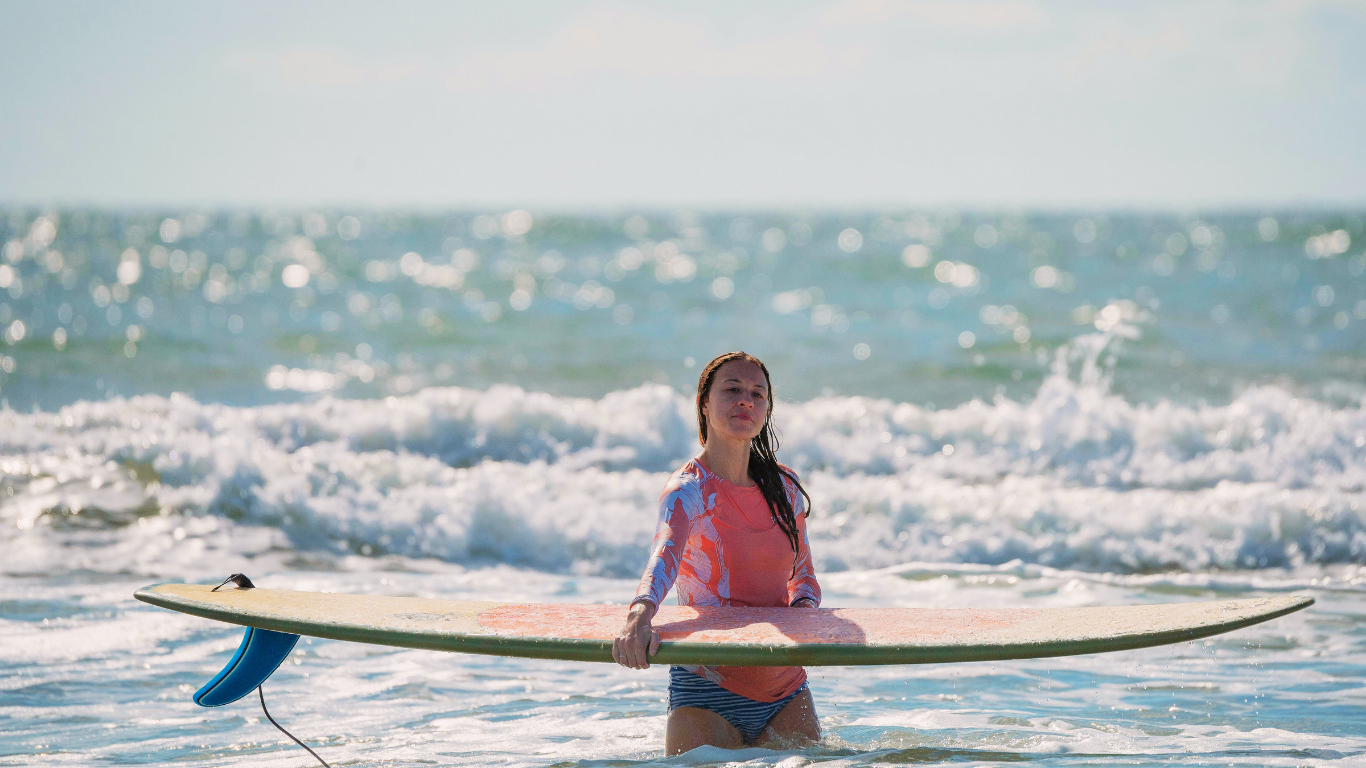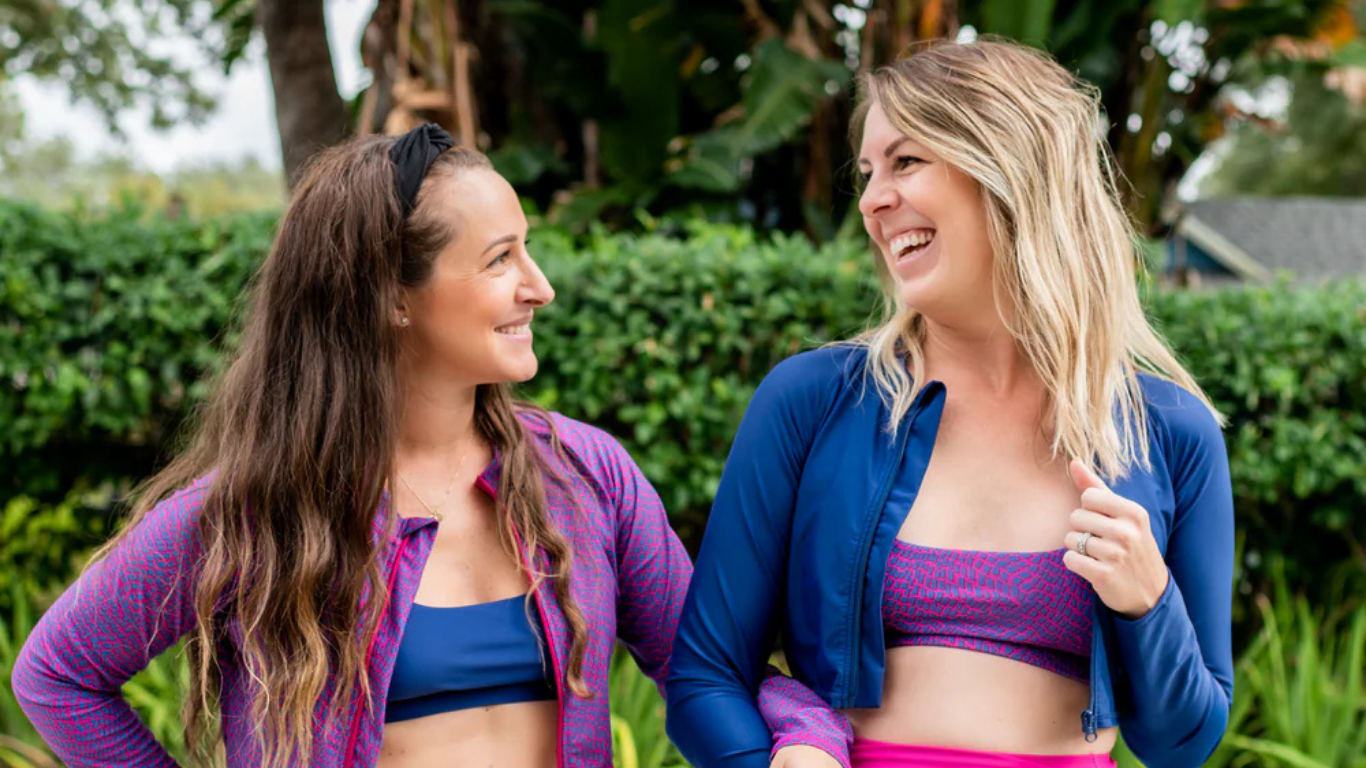
What are rash guards made of?
Rash guards are your summer battle armor. They hug the body and protect against sunburn and surf rash, so your beach days can be active and safe. If you already wear one, you know the comfort. But what are rash guards made of?
A rash guard’s fabric composition gives it sun safety, stretch, and durability. Learn about the fibers that protect you from sun and surf, so you can get a rash guard that keeps up with your active summer.
Polyester
Polyester comes from petroleum-derived chemicals called polyethylene terephthalate (PET). It is in the majority of rash guard blends, with the remainder usually being spandex for stretch.
Polyester has natural UV absorption properties, but achieving reliable UPF 50+ protection requires careful fabric construction, tight weaves, and often additional treatments. It also tends to pill and stretch more than other materials over time.
Polyester is:
- Pool-friendly: resists chlorine damage better than some alternatives
- Lasting vividness: holds dyes well in most conditions
- Easy to blend: works with various other fibers
Many rash guards use polyester, but the real performance comes from how the fabric is engineered, not just the material.
Nylon
Nylon is made from petroleum-based chemicals called polyamides. It appears in many rash guard blends, often combined with spandex for performance. While naturally less UV-resistant than polyester, it can be improved to achieve excellent UV protection. And nylon's other properties make it the base material for high-end rash guards.
Nylon requires special treatments or tight weaves to achieve serious UV protection. Quality manufacturers can engineer nylon blends to reach UPF 50+ standards.
Nylon has:
- Superior abrasion resistance: won't snag on rough surfaces, like pool decks
- Shape retention: maintains fit through countless washes
- Smooth texture: reduces chafing during extended wear
- Enhanced durability: outlasts many other synthetic fibers
SwimZip uses premium nylon/spandex blends engineered to UPF 50+ in our kids’ rash guards and long-sleeve rash guards for durability that lasts season after season.
Spandex, elastane, and Lycra
Spandex (also called elastane or Lycra) is made from polyurethane, a synthetic polymer that can stretch up to 500 percent of its length. Quality rash guards contain 10–20 percent spandex, always blended with nylon or polyester, since spandex provides no UV protection.
Too much spandex actually reduces sun safety because stretched fabric opens the weave and lets UV rays through. The optimal ratio balances flexibility with protection.
Spandex has:
- Four-way stretch: allows unrestricted movement in water sports
- Recovery power: snaps back to its original shape after stretching
- Close fit: hugs body contours without binding or gapping
Our boys’ rash guards feature balanced fabric blends that stretch without compromising sun safety.
Polypropylene
Polypropylene is a light, water-shedding fiber. That makes it quick-drying and comfortable in hot, humid places. It also moves moisture away from the skin through moisture wicking, so you feel cooler.
Polypropylene is less common than nylon or polyester because it has less UV protection and traps less heat.
Polypropylene is:
- Quick drying: stays light even when wet
- Moisture wicking: keeps skin cooler and drier
- Lightweight: comfortable to wear in hot weather
Neoprene
Neoprene is made from chloroprene, a synthetic rubber. It's not used in most rash guards but is added to cold-water gear at 2–5mm thicknesses. Neoprene can’t be blended with spandex or other fabrics, but it can be sandwiched into nylon, polyester, or spandex shells or casings.
This material is more of a wetsuit technology than a typical rash guard fabric. Most recreational swimmers don’t get neoprene rash guards; they wear a standard rash guard underneath a wetsuit instead.
Neoprene offers:
- Insulation: traps body heat for cold water activities
- Impact protection: cushions against boards and rough surfaces
- Buoyancy: slightly floats
Sustainable and recycled fabrics
Recycled fibers are created by breaking down existing materials and reforming them into new yarn. For example, regenerated nylon such as ECONYL comes from discarded fishing nets and fabric waste. And recycled polyester is made from plastic bottles and textile scraps.
Natural and plant-based fibers offer another sustainable path. Bamboo fabric comes from pulp processed into soft fibers and has decent durability and UV protection. Organic cotton, hemp, and other plant-based materials can be used to make rash guards, though they require synthetic blending to achieve the durability, stretch, and protection that people expect from rash guards.
Sustainable fabrics are:
- Environmentally friendly: reduces landfill waste and ocean plastic
- High-performing: can match virgin fiber strength and UV resistance
- Innovation drivers: supports the development of circular textiles economy
Rash guard performance qualities
If you’re researching rash guards, you shouldn’t necessarily focus on the fabric. Some brands have proprietary blends that outperform, and some brands advertise the fabric but use cheap manufacturing techniques that don’t translate to protection or durability.
Instead, focus on advertised performance qualities. If you focus on a rash guard’s abilities, you’ll likely end up with the right garment (and it might not be the fabric you anticipated). When looking for your next rash guard, search for these attributes.

Quick drying technology
Synthetic fibers, like polyester, nylon, and polypropylene, absorb little water. This keeps the shirt light and quick drying after a swim. The fabric structure affects how fast moisture evaporates.
Chlorine resistance
Polyester blends withstand chlorinated pools. They resist stretch, sag, and fading caused by pool chemicals. Chlorine resistance extends the life of your swim top.
Four-way stretch
Spandex allows more movement. Four-way stretch means the fabric pulls in every direction instead of just across. This flexibility prevents binding and constriction.
Abrasion resistance
Tightly woven nylon protects against sand, boards, and rough decks. Abrasion resistance keeps your rash vest looking new longer.
Breathability
Polypropylene offers the best breathability due to its moisture-repelling properties. Nylon also provides excellent airflow in a lightweight weave. Polyester can feel less breathable, and bamboo offers good breathability but wears out quicker.
Flatlock seams for comfort
Overlapping seams create bulk and chafing points. Flatlock seams lie smooth against skin. They reduce rubbing and keep movement comfortable, so long beach days are more pleasant.
SwimZip incorporates all these performance features into our zipper rash guards, making them easy to put on and comfortable to wear all day.
How to choose a rash guard based on fabric
Since rash guards are performance attire, you should choose one based on how you plan to use it:
- For sun protection: nylon or polyester blends with UPF 50+ are safest
- For stretch and comfort: nylon or polyester blended with 10–20 percent spandex
- For cold water: thicker neoprene-based rash guards add warmth
- For pool use: polyester and nylon blends resist chlorine and fading
- For eco-conscious shoppers: look for recycled nylon, recycled polyester, or bamboo
- For high visibility: neon colors in nylon blends for water safety
Our high-visibility swimwear collection features bright neon colors that keep children visible in the water. Learn more about the best swimsuit colors for safety to make informed choices for your family.
Experience rash guards by SwimZip
At SwimZip, every rash guard is made with UPF 50+ tested fabric. That means each shirt blocks 98 percent of UVA and UVB rays. Our rash guards feature premium nylon/spandex blends that balance durability, stretch, sun protection, and style. Plus, every SwimZip sun-protective swimwear piece carries the Skin Cancer Foundation seal of recommendation for superior UV resistance.
Our rash guards feature:
- Quick drying technology
- Four-way stretch
- Flatlock seams
- Durable colors
- Styles and sizes for the whole family
Shop SwimZip's complete rash guard collections:
- Kids’ rash guards: fun, protective styles for active children
- Women’s rash guards: flattering fits with serious sun protection
- Men’s rash guards: performance-focused designs for water sports
- Long-sleeve rash guards: maximum coverage for extended sun exposure
- Zipper rash guards: easy on-off convenience for all ages
Protect your family with swimwear that puts safety first without sacrificing style.
Rash guard fabrics FAQ
Are rash guards ever made of cotton?
Rarely. Cotton soaks up water and dries slowly. It stretches out and offers poor UV protection. Synthetic blends create the most effective rash guards.
Are rash guards and swim shirts the same?
Swim shirts and rash guards are different. Swim shirts are loose-fitting and protect against UV rays. They are similar to rash guards, but rash guards are form-fitting and abrasion-resistant. Swim shirts are for casual use, while rash guards are performance attire.
Does more spandex mean better performance?
More spandex means more stretch, but too much reduces UV protection because the fabric thins when pulled. High spandex blends can also cause drag in the water. Most rash guards have a spandex fabric ratio of less than 20 percent.
How does fabric stretch affect UPF?
Stretching opens the weave and lets more sun through. Even a UPF 50+ fabric can lose some protection when stretched tight. That’s why blend ratios are common in sun protective clothing. A dense weave with sufficient stretch is comfortable and protective.
How long does UV protection last in rash guard fabric?
With good care, the UPF rating lasts for many seasons. Sun, chlorine, and rough use break down fibers over time. Follow proper swimsuit care techniques to preserve your garment.
Do I need to wear anything under a rash guard?
Rash guards are usually comfortable with or without base layers. Zipper styles make it easy to adjust coverage and ventilation. Many women prefer wearing bikini tops or sports bras underneath for style, comfort, and support.
What should kids wear under their rash guards?
Young children often wear swimsuits underneath for easier bathroom breaks. Boys’ and girls’ rash guard sets include separate pieces that coordinate and provide proper coverage. Older kids can follow the same guidelines as adults.
Should I apply sunscreen under my rash guard?
Apply SPF 30 sunscreen to exposed skin. If you buy swimwear with UPF 50+ fabric, your covered areas will be protected all day.
Learn more about UPF vs SPF to understand the difference between fabric and sunscreen protection.



Leave a comment
This site is protected by hCaptcha and the hCaptcha Privacy Policy and Terms of Service apply.